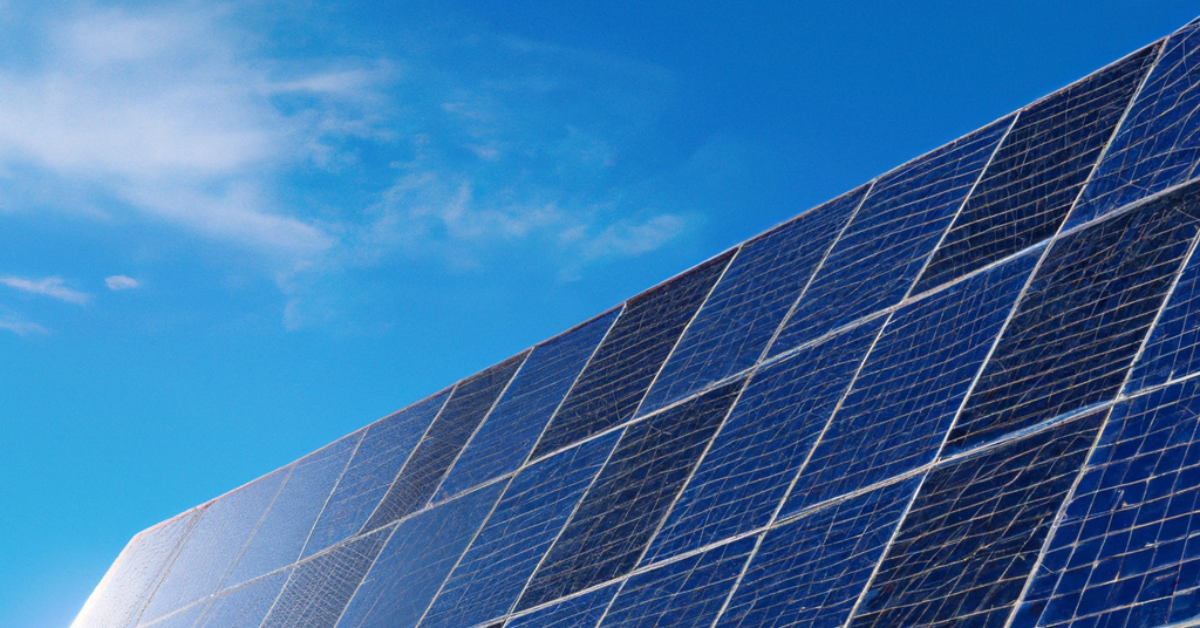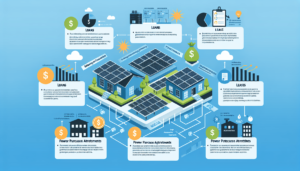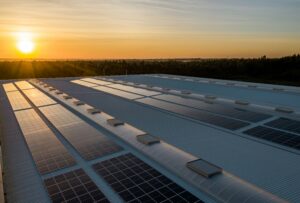Introduction
Welcome to the fascinating world of solar energy! This article will explore the incredible benefits, applications, challenges, and other facts about solar energy, promising an exciting future! Get ready to dive into the realm of harnessing the sun’s power and discover how it can revolutionize how we generate and consume electricity. So, let’s embark on this enlightening journey together!
What is Solar Energy?
Solar energy, the radiant light, and heat emitted by the sun, holds immense potential as a clean and renewable energy source. The captivating fact about solar energy is that it can be converted into usable electricity through various technologies. One of the most common methods is using photovoltaic (PV) cells, which directly convert sunlight into electricity. Another approach is concentrated solar power (CSP) systems, which concentrate sunlight onto a receiver to generate heat, subsequently used to produce electricity. The sun, our very own celestial powerhouse, provides an abundant and sustainable source of energy that can be harnessed to power our homes, businesses, and even entire cities.
Advantages of Solar Energy
The advantages of solar energy are truly remarkable. Firstly, solar energy is a renewable source, meaning it will never run out as long as the sun continues to shine. Unlike fossil fuels, solar energy production does not contribute to harmful greenhouse gas emissions, making it an environmentally friendly choice. By embracing solar energy, we can combat climate change and improve air quality, leading to a cleaner and greener planet. Additionally, solar energy systems require minimal maintenance, and as technology advances, solar panels have become more efficient and affordable. Installing solar panels can significantly reduce electricity bills, offering long-term financial savings.
Types of Solar Energy Systems
Solar energy systems can be broadly categorized into two main types: photovoltaic (PV) systems and concentrated solar power (CSP) systems. Let’s explore each type in more detail:
Photovoltaic (PV) Systems
PV systems are the most commonly used solar energy systems. They directly convert sunlight into electricity through the photovoltaic effect. PV systems consist of solar panels made up of multiple interconnected solar cells. These solar cells are typically composed of semiconductor materials, such as silicon.
When sunlight strikes the solar cells, it excites the electrons within the semiconductor material, creating an electric current. This direct conversion of sunlight into electricity is the key characteristic of PV systems. The electricity generated by PV systems can be used to power homes, businesses, and various electronic devices.
PV systems are highly versatile and can be installed in various locations, ranging from residential rooftops to large-scale solar farms. They are commonly used in both on-grid and off-grid applications. On-grid PV systems are connected to the electrical grid, allowing excess electricity to be fed back into the grid, often leading to financial incentives through net metering programs. On the other hand, off-grid PV systems are not connected to the grid and are commonly used in remote areas where access to traditional power sources is limited.
Advancements in PV technology have led to increased efficiency and affordability. Solar panels are becoming more compact – like portable solar panels -, durable, and aesthetically pleasing, making them a viable option for a wide range of applications.
Concentrated Solar Power (CSP) Systems
CSP systems utilize mirrors or lenses to concentrate sunlight onto a receiver, which converts the sunlight into heat. This heat is then used to generate electricity through various means, such as steam turbines.
There are several different types of CSP systems, each with its own unique design and method of harnessing solar energy. Some common types include:
- Parabolic Trough Systems: This type of CSP system uses parabolic-shaped mirrors to concentrate sunlight onto a receiver tube located at the focal point of the trough. The receiver tube contains a heat transfer fluid, such as oil, which absorbs the concentrated sunlight and reaches high temperatures. The heated fluid then transfers its thermal energy to water, producing steam that drives a turbine to generate electricity.
- Solar Power Tower Systems: Solar power tower systems use an array of mirrors, known as heliostats, to reflect and concentrate sunlight onto a central receiver located on top of a tower. The concentrated sunlight heats a working fluid within the receiver, such as molten salt or steam. The heated fluid is then used to generate steam, which drives a turbine to produce electricity.
- Dish Systems: Dish systems utilize a large, dish-shaped reflector to concentrate sunlight onto a receiver located at the dish’s focal point. The receiver typically contains a Stirling engine, which converts the heat from the concentrated sunlight into mechanical energy. The mechanical energy is then used to generate electricity.
CSP systems are often used for large-scale solar power generation. They are particularly suitable for areas with high direct normal irradiance (DNI), where the concentration of sunlight is abundant. CSP technology has the advantage of storing heat, allowing for electricity production even when the sun is not shining, increasing the reliability and dispatchability of the system.
In recent years, hybrid systems that combine PV and CSP technologies have also emerged, harnessing the benefits of both approaches. These hybrid systems offer the advantages of PV systems in terms of simplicity and scalability while also incorporating CSP systems’ thermal energy storage capabilities.
Each type of solar energy system, whether PV or CSP, has its own unique characteristics and applications. The system choice depends on factors such as location, energy requirements, and cost considerations. You may even like to consider flexible solar panels. As solar energy technology continues to advance, we can expect further improvements in efficiency, cost-effectiveness, and integration with existing power infrastructure.
Facts About Solar Energy: How Does It Work?
Understanding how solar energy works is key to appreciating its power. In PV systems, solar panels comprise numerous interconnected solar cells. These cells consist of a semiconductor material, such as silicon, that absorbs sunlight. When sunlight strikes the solar cells, it excites electrons within the semiconductor material, creating an electric current. This flow of electricity can be used immediately or stored in batteries for later use. On the other hand, CSP systems employ mirrors or lenses to concentrate sunlight onto a receiver, which heats a working fluid, such as water or molten salt. The generated heat is then used to produce steam, which drives a turbine to generate electricity.
Solar Energy Applications
Solar energy applications span various sectors, making it a versatile and indispensable power source. In residential settings, solar panels can be installed on rooftops, allowing homeowners to generate their own electricity and reduce dependence on the grid. This leads to significant cost savings and contributes to energy independence. Solar energy also finds extensive applications in commercial buildings and industries. By utilizing solar power, businesses can reduce operational costs and their environmental footprint, showcasing their commitment to sustainability. Additionally, solar energy plays a crucial role in powering remote areas and communities that are not connected to the traditional power grid. From agriculture to solar water pumps and even transportation, solar energy is transforming industries and creating a more sustainable future.
Environmental Benefits
One of the most compelling aspects of solar energy is its positive environmental impact. We can significantly reduce air pollution and combat climate change by transitioning from fossil fuels to renewable energy sources like solar power. Solar energy production generates no greenhouse gas emissions or air pollutants, ensuring cleaner and healthier air for future generations. Moreover, the use of solar energy helps conserve finite natural resources and reduces the reliance on fossil fuels, mitigating the environmental impacts associated with their extraction and combustion. Embracing solar energy is a powerful step towards a more sustainable and eco-friendly future.
Economic Benefits
In addition to its environmental advantages, solar energy offers remarkable economic benefits. The cost of solar systems has significantly decreased over the years, thanks to technological advancements and increased adoption. Homeowners and businesses can experience long-term financial savings through reduced electricity bills by installing solar panels. In some cases, excess solar energy can be sold back to the grid, allowing individuals to earn money through feed-in tariffs or net metering programs. Moreover, the solar industry itself creates job opportunities in manufacturing, installation, maintenance, and research. This stimulates economic growth and contributes to the development of a skilled workforce. By embracing solar energy, we protect the environment and strengthen our economies.
Challenges of Solar Energy
While solar energy has numerous advantages, it also faces certain challenges. One of the primary challenges is the intermittency of sunlight. Solar energy generation is affected by factors such as weather conditions and the time of day, which can lead to fluctuations in energy output. However, advancements in energy storage technologies, such as batteries, are addressing this challenge by enabling the storage of excess energy for later use. Another challenge is the initial cost of installing solar systems. While the long-term financial benefits outweigh the upfront investment, the initial expenses can be a barrier for some individuals or businesses. However, various financing options, government incentives, and tax credits are available to make solar energy more accessible and affordable.
Facts About Solar Energy: The Future
The future of solar energy is filled with promise and potential. As technology advances, solar panels become more efficient, affordable, and aesthetically pleasing. Emerging innovations, such as solar roof tiles and flexible solar panels, are revolutionizing the integration of solar energy into our daily lives. Moreover, researchers focus on enhancing energy storage capabilities, developing more efficient solar materials, and expanding solar farms to meet the increasing energy demands sustainably. With continued investments in research and development, solar energy is poised to play a significant role in our quest for a sustainable future.
Facts About Solar Energy and Sustainability
Solar energy is intricately linked to the concept of sustainability. By harnessing the sun’s power, we can transition to a more sustainable energy system that reduces reliance on fossil fuels and mitigates the impacts of climate change. Solar energy empowers individuals, communities, and nations to embrace clean and renewable sources of power, contributing to a more secure and resilient energy future. Embracing solar energy benefits the environment and improves the quality of life for present and future generations.
Conclusion
Considering all these facts about solar energy, it’s clear that solar energy is a remarkable force that holds the potential to transform our world. From its renewable nature and environmental benefits to its diverse applications and positive economic impacts, solar energy stands as a beacon of hope for a sustainable and prosperous future. We can reduce our carbon footprint by harnessing the sun’s power, combat climate change, and create a cleaner and healthier planet. So, let us join hands and embrace the incredible power of solar energy to shape a brighter future for all.
Facts About Solar Energy FAQs
Is solar energy suitable for all geographical locations?
Solar energy can be harnessed in various geographical locations, although the amount of sunlight received may vary. While regions with abundant sunshine, such as deserts, are ideal for solar energy generation, solar systems can still be installed in areas with less sunlight. The efficiency of a solar powered generator and the energy output may be influenced by factors like latitude, climate, and shading. It is recommended to assess the solar potential of your specific location to determine the feasibility and effectiveness of solar energy utilization.
Can solar energy be used during power outages?
Solar energy systems can provide electricity during power outages depending on the setup. Grid-tied solar systems without energy storage will not function during an outage to protect utility workers. However, by incorporating energy storage solutions like batteries, you can store excess solar energy and use it as backup power when the grid is down. These backup systems provide a reliable source of electricity during emergencies, ensuring uninterrupted power supply for essential appliances or even the entire home.
Are solar panels durable and long-lasting?
Solar panels are designed to be durable and long-lasting. Most solar panels come with warranties ranging from 25 to 30 years, indicating their expected lifespan. With proper installation and regular maintenance, solar panels can continue to generate electricity efficiently for several decades. They are built to withstand various weather conditions, including rain, snow, hail, and high winds. Investing in reputable solar panels from trusted manufacturers and following recommended maintenance practices can ensure their longevity and optimal performance.
How much money can I save by installing solar panels?
The amount of money you can save by installing solar panels depends on several factors, including your location, energy consumption, system size, and local electricity rates. By generating your own electricity from solar energy, you can reduce your reliance on the grid, resulting in lower monthly electricity bills. Sometimes, homeowners with solar panels can even eliminate their electricity bills entirely. The exact savings will vary from person to person. Still, over the long term, solar panels can provide significant financial benefits by offsetting electricity costs and offering a solid return on investment.
What are the incentives available for adopting solar energy?
Many incentives are available to encourage the adoption of solar energy. These incentives vary by country, state, and even utility company. Some common incentives include tax credits, grants, rebates, and net metering programs. Tax credits can provide a percentage of the installation cost as a deduction on your income taxes. Rebates and grants offer financial assistance for purchasing and installing solar energy systems. Net metering allows you to sell excess solar energy back to the grid, earning credits or payments from your utility company. It is advisable to check with local authorities and utilities to explore the specific incentives available in your area.





Pingback: How Do Solar Panels Work: A Guide for Curious Minds
Pingback: Solar Powered Generator: The Future of Sustainable Energy
Pingback: Off Grid Wind Turbine: Harness the Power of Wind - Eco Life Wise
Pingback: Self Sustaining Homes: A Definitive Guide to the Exciting Future
Pingback: Composting 101: In the (Sustainable and Eco Friendly) Beginning
Pingback: Why is Recycling Important? A Definitive Guide - Eco Life Wise
Pingback: Pros and Cons of Solar Energy: Weighing it Up - Eco Life Wise
Pingback: Solar Panel Kits: Embrace the Convenience of Solar Power
Pingback: Off Grid Solar System: A Step Toward Self Sufficiency
Pingback: Off Grid Trailers: The Ultimate Guide - Eco Life Wise
Pingback: Facts About Recycling: Conserving Resources & Building Sustainability
Pingback: Three Pillars of Sustainability: A Guide to a Better Future
Pingback: Solar 5e: Harnessing the Sun's Energy Like Never Before
Pingback: 15 Facts About Recycling You Probably Didn't Know
Pingback: The Solar Shower: Making a Splash the Eco Way - Eco Life Wise
Pingback: Solar Farms: Harnessing the Power of the Sun - Eco Life Wise
Pingback: Off Grid Air Conditioner: A Green Solution to Beat the Heat
Pingback: How to Live Off the Grid: Your Ultimate Guide
Pingback: What is Fracking? The Eye-Opening Reality of Hydraulic Fracturing | Eco Life Wise
Pingback: Most Efficient Solar Panels: A Comprehensive Guide
Pingback: Living Off the Grid Communities: A Practical Guide
Pingback: Recycle Projects for Kids: Crafting a Greener Future
Pingback: Building Off the Grid: A Guide to a Self-Sustained Lifestyle
Pingback: Eco Friendly Cars: The Journey Toward Sustainable Driving
Pingback: Solar Water Pump: Sustainable Water Solutions | Eco Life Wise
Pingback: Flexible Solar Panels: Eco Friendliness With a Bend & a Twist!
Pingback: The Solar Battery: Ensuring A Future of Sustainable Energy
Pingback: Pros and Cons of Renewable Energy | Eco Life Wise
Pingback: Eco Friendly Gifts: A Sustainable Guide | Eco Life Wise
Pingback: How to Extend Your Swimming Season With a Solar Pool Heater
Pingback: Sustainable Living: A Journey from Cliche to Lifestyle | Eco Life Wise
Pingback: Climate Change Reality: The Unvarnished Truth We Can't Ignore | Eco Life Wise
Pingback: Causes of Global Warming: The Unsettling Reality | Eco Life Wise
Pingback: Advantages of Renewable Energy: Embracing a Cleaner Future | Eco Life Wise
Pingback: Examples of Natural Resources: Unearthing Earth's Treasures | Eco Life Wise
Pingback: Climate Change Facts for Kids: A Cool Guide for a Hot Topic | Eco Life Wise
Pingback: Portable Solar Panels: An Anywhere, Anytime Solution
Pingback: Benefits of Renewable Energy: The Future is Bright (and Windy!) | Eco Life Wise
Pingback: How Do Electric Cars Help The Environment? 7 Practical Points to Ponder | Eco Life Wise
Pingback: The Solar Water Fountain: Top 5 Picks For Your Outdoor Space
Pingback: Solar Energy Pros and Cons: A Comprehensive Guide | Eco Life Wise
Pingback: Solar Energy Pros and Cons: 8 Considerations | Eco Life Wise
Pingback: How Can I Make My Home More Energy Efficient? 10 Simple Steps | Eco Life Wise
Pingback: How Do Solar Panels Work? New Solar Panels 101 | Eco Life Wise
Pingback: Commercial Solar Panels: Exploring the Lifespan | Eco Life Wise
Pingback: Examples of Sustainability: How They Shape Our World | Eco Life Wise
Pingback: What Is The Greenhouse Effect? | Eco Life Wise
Pingback: Sustainable Development Goals: 17 Nuggets
Pingback: How Can I Reduce My Carbon Footprint? 8 Simple Ways | Eco Life Wise
Pingback: Renewable Energy Sources: 10 Ways They Help Reduce Greenhouse Emissions | Eco Life Wise
Pingback: Solar Farms: Solar Works NJ Proven Number 1 at Empowering the Future | Eco Life Wise
Pingback: What Are The Main Sources Of Renewable Energy? Discover the 6 Pillars | Eco Life Wise
Pingback: Why Are Rainforests Often Referred To As The Lungs Of Our Planet? | Eco Life Wise
Pingback: Charge Your Electric Car With Solar Panels: The Ultimate Guide to Green Energy! | Eco Life Wise
Pingback: How Do Self-sustaining Homes Differ From Regular Homes? | Eco Life Wise
Pingback: Why Is Clean Air Essential For Human Health? 10 Compelling Reasons | Eco Life Wise
Pingback: Why Are Solar Panels Considered A Green Energy Source? | Eco Life Wise
Pingback: What Role Do Materials Play In Self-Sustaining Architecture? 10 Considerations | Eco Life Wise
Pingback: What Is The Role Of Energy Storage In Renewable Energy Systems? | Eco Life Wise
Pingback: How Does Renewable Energy Contribute To Reducing Greenhouse Gas Emissions? | Eco Life Wise
Pingback: How Do Off-Grid Communities Source Water And Power? | Eco Life Wise
Pingback: Hiluckey Solar Charger Review | Eco Life Wise
Pingback: Victron Energy BlueSolar MPPT 100V 30 amp 12/24-Volt Solar Charge Controller Review | Eco Life Wise
Pingback: Victron Energy SmartSolar MPPT Tr 250V 60 Amp Solar Charge Controller Review | Eco Life Wise
Pingback: Anker Solix PS30 Solar Panel Review | Eco Life Wise
Pingback: Solar Energy Hope for the Future VHS Review | Eco Life Wise
Pingback: WYWNA Solar Street Light Review: 10 Amazing Facts | Eco Life Wise
Pingback: Amarine Made Water Pump Review: 10 Things You Should Know | Eco Life Wise
Pingback: Victron Energy BlueSolar Charge Controller Review | Eco Life Wise
Pingback: Solar Load Tests: 10 Things You Should Know | Eco Life Wise